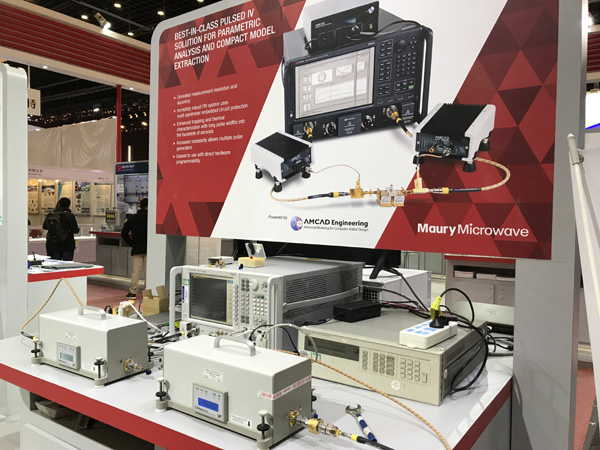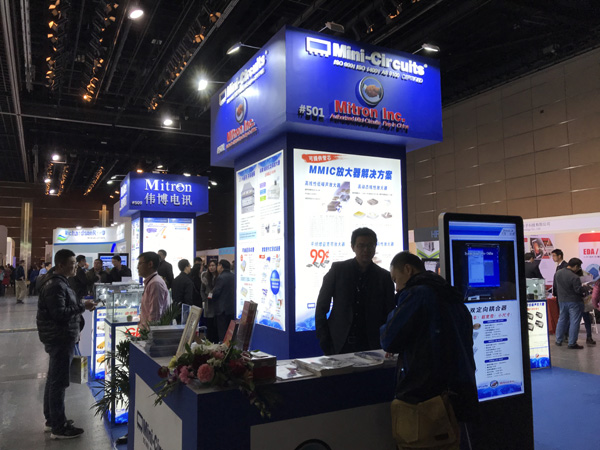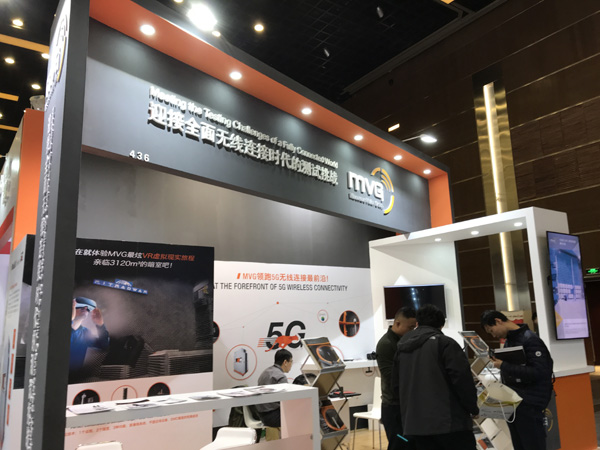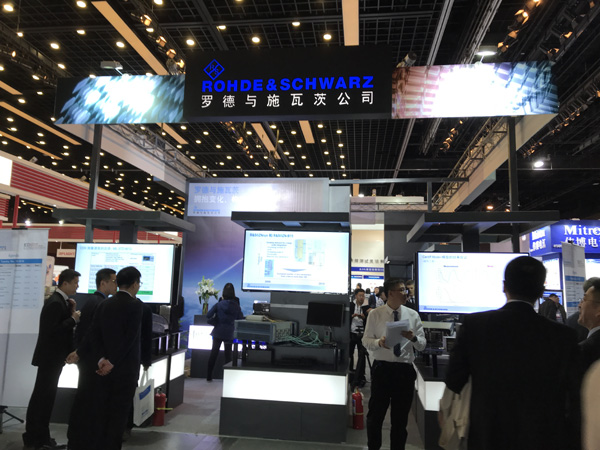 Maury Microwave was featuring a comprehensive line of coaxial and waveguide VNA calibration kits, which consist of accurate, stable, and precise calibration standards for a broad range of VNA models. When properly used, these kits ensure a true evaluation of VNA performance. Maury kits offer a range of performance and cost options which provide users with choices that are both technically and economically suitable for a variety of intended application. They were also featuring calibration-grade metrology, precision, and lab interconnect solutions including cable assemblies, adapters and more. Maury Microwave's Stability™ series sets the standard for high-performance ruggedized microwave/RF cable assemblies. Designed specifically for phase-stable and amplitude-stable applications, Stability™ offers excellent measurement repeatability even after cable flexure. Maury was also featuring their various characterization systems such as device characterization for power amplifier design. The ideal form of the amplifier device data is a large signal model from which the performance can be analyzed for varying drive and impedance conditions, so complex or multi-stage circuits can be designed. A method of formulating a large signal model is to use a measurement-based behavioral approach, as with the X-Parameter model. This is based on measurements of X-parameters, which are a superset of S-parameters for nonlinear components, and are measured using a Non-linear Vector Network Analyzer. Maury supplies various systems to characterize and models all types of devices.
Maury Microwave was featuring a comprehensive line of coaxial and waveguide VNA calibration kits, which consist of accurate, stable, and precise calibration standards for a broad range of VNA models. When properly used, these kits ensure a true evaluation of VNA performance. Maury kits offer a range of performance and cost options which provide users with choices that are both technically and economically suitable for a variety of intended application. They were also featuring calibration-grade metrology, precision, and lab interconnect solutions including cable assemblies, adapters and more. Maury Microwave's Stability™ series sets the standard for high-performance ruggedized microwave/RF cable assemblies. Designed specifically for phase-stable and amplitude-stable applications, Stability™ offers excellent measurement repeatability even after cable flexure. Maury was also featuring their various characterization systems such as device characterization for power amplifier design. The ideal form of the amplifier device data is a large signal model from which the performance can be analyzed for varying drive and impedance conditions, so complex or multi-stage circuits can be designed. A method of formulating a large signal model is to use a measurement-based behavioral approach, as with the X-Parameter model. This is based on measurements of X-parameters, which are a superset of S-parameters for nonlinear components, and are measured using a Non-linear Vector Network Analyzer. Maury supplies various systems to characterize and models all types of devices.
 Mini Circuits/Mitron highlighted its expansive selection of RF/microwave components, including its ZVBP line of bandpass filters, MNA line of monolithic amplifiers, as well as its range of MMICs. Mini-Circuits was a finalist in the EDI CON China Product Innovation Awards with a 100 W surface mount dual directional coupler with 36 dB nominal coupling covering 225 to 2500 MHz. The coupler offers high power handling in a miniature, printed laminate form factor (1.0 x 1.0 x 0.128”). While coupler selection typically involves a tradeoff between flat coupling (core and wire construction) and low loss (stripline construction), Mini-Circuits DDCH-35-252+ utilizes proprietary design with stripline construction to achieve 0.15 dB insertion loss and ±0.6 dB flatness across a bandwidth of greater than 1 decade. Mitron, Mini Circuits’ strategic partner and representative, featured a wideband high resolution multi-channel phase & amplitude control matrix that can realize the control of phase & amplitude of the signal. It can be used to do simulation and test of the electromagnetic signal environment, over-the-air (OTA) beamforming algorithms, antenna arrays and the entire 5G system. Also it can be used to work with vector network analyzer of signal generator to configure multi-channel phase & amplitude separately but synchronized controlled, coherent vector signal generator, which will be the important test instrument for 5G and antenna array.
Mini Circuits/Mitron highlighted its expansive selection of RF/microwave components, including its ZVBP line of bandpass filters, MNA line of monolithic amplifiers, as well as its range of MMICs. Mini-Circuits was a finalist in the EDI CON China Product Innovation Awards with a 100 W surface mount dual directional coupler with 36 dB nominal coupling covering 225 to 2500 MHz. The coupler offers high power handling in a miniature, printed laminate form factor (1.0 x 1.0 x 0.128”). While coupler selection typically involves a tradeoff between flat coupling (core and wire construction) and low loss (stripline construction), Mini-Circuits DDCH-35-252+ utilizes proprietary design with stripline construction to achieve 0.15 dB insertion loss and ±0.6 dB flatness across a bandwidth of greater than 1 decade. Mitron, Mini Circuits’ strategic partner and representative, featured a wideband high resolution multi-channel phase & amplitude control matrix that can realize the control of phase & amplitude of the signal. It can be used to do simulation and test of the electromagnetic signal environment, over-the-air (OTA) beamforming algorithms, antenna arrays and the entire 5G system. Also it can be used to work with vector network analyzer of signal generator to configure multi-channel phase & amplitude separately but synchronized controlled, coherent vector signal generator, which will be the important test instrument for 5G and antenna array.
 MVG was featuring their StarLab 50 GHz that is a compact and portable measurement system that frees up space in laboratories and production environments, plus saves costs. Delivering ultra-fast and accurate test results using near-field, spherical technology, StarLab 50 GHz provides a future-proof turnkey solution for 5G system development and validation. MVG also highlighted its expertise and achievement through their workshop and panel participation. MVG delivered an IoT Testing Workshop: " Mastering IoT testing challenges: protocol choices and OTA test solutions to successfully implement wireless connectivity in IoT devices " and were part of the expert panel on 5G mmWave OTA Testing the same day.
MVG was featuring their StarLab 50 GHz that is a compact and portable measurement system that frees up space in laboratories and production environments, plus saves costs. Delivering ultra-fast and accurate test results using near-field, spherical technology, StarLab 50 GHz provides a future-proof turnkey solution for 5G system development and validation. MVG also highlighted its expertise and achievement through their workshop and panel participation. MVG delivered an IoT Testing Workshop: " Mastering IoT testing challenges: protocol choices and OTA test solutions to successfully implement wireless connectivity in IoT devices " and were part of the expert panel on 5G mmWave OTA Testing the same day.
 National Instruments’ booth boasted two EDI CON Innovation Awards finalists: the MIMO Prototyping System, a modular testing system for MIMO research that can scale from 4 to 128 channels and the mmWave Transcevier System, another modular platform that is well suited for prototyping real-time two-way communications systems. The NI/AWR booth presentations included Microwave Office for MMIC, RF PCB and module design, Visual System Simulator (VSS) for wireless Communications and radar systems, analyst and AXIEM Electromagnetic (EM) technology for interconnect analysis, and AntSyn for antenna synthesis and optimization. They also participated in the plenary session giving a keynote talk on “A Platform based Approach to 5G: Design, Prototyping and Test” delivered by Luke Schreier, VP of Automated Test Marketing, National Instruments. The presentation addressed test challenges, how tests are matched to standards, and how we can look to the past and apply systems-thinking to a connected world from beam steering, synchronization, to lowering the cost of millimeter wave measurement. As the corporate sponsor, NI presented many technical sessions plus presented a couple of workshops and participated on several panels.
National Instruments’ booth boasted two EDI CON Innovation Awards finalists: the MIMO Prototyping System, a modular testing system for MIMO research that can scale from 4 to 128 channels and the mmWave Transcevier System, another modular platform that is well suited for prototyping real-time two-way communications systems. The NI/AWR booth presentations included Microwave Office for MMIC, RF PCB and module design, Visual System Simulator (VSS) for wireless Communications and radar systems, analyst and AXIEM Electromagnetic (EM) technology for interconnect analysis, and AntSyn for antenna synthesis and optimization. They also participated in the plenary session giving a keynote talk on “A Platform based Approach to 5G: Design, Prototyping and Test” delivered by Luke Schreier, VP of Automated Test Marketing, National Instruments. The presentation addressed test challenges, how tests are matched to standards, and how we can look to the past and apply systems-thinking to a connected world from beam steering, synchronization, to lowering the cost of millimeter wave measurement. As the corporate sponsor, NI presented many technical sessions plus presented a couple of workshops and participated on several panels.
 Pasternack won an EDI CON China Product Innovation Award for the PEM010, a complete millimeter wave transmitter module that is well-suited for use in the development of multi-gigabit, high-speed, point-to-point wireless communication links. These communication links provide low-cost, gigabit wireless throughput for a variety of applications involving telecommunications “last kilometer” distribution, telecommunications cellular backhaul, millimeter wave wireless gigabit Ethernet data communications, building-to-building high speed networks and mesh-based LAN infrastructures. They were also featuring. Pasternack also unveiled a new series of new series of low insertion loss, repeatability electromechanical switches. Test and measurement applications require signal processing component performance to be highly accurate and repeatable over long periods and under extreme conditions. In automated test systems where, electromechanical switches are used for signal monitoring and routing applications, every switch will add repeatability error. Electromechanical switches which exhibit low insertion loss repeatability over millions of switching cycles help to ensure overall system measurement accuracy is maintained. Typical applications for these switches include test instrumentation, electronic warfare, electronic countermeasures, microwave radio, VSWT, radar, space systems and research and development. Pasternack’s also featured four new high-performance, flexible VNA test cables that operate at up to 110 GHz and deliver precise results for testing using a coaxial cable and 1.0mm stainless steel connector interfaces. The coaxial test cable is covered by a non-conductive Nomex® outer sleeve. This light-duty armoring protects the small, 0.27-inch diameter VNA cable and improves stability during flexure. These cables feature 50 Ohm impedance with a maximum VSWR of 1.5:1 and excellent phase/amplitude stability under flexure. The new flexible 1.0 mm VNA test cables operate over a wide range of temperatures from -65°C to +125°C. The vector network analyzer cables are RoHS and REACH compliant, plus the cable assembly is fully tested and comes with serialized test data. These network analyzer cables are available in standard 6-inch and 12-inch lengths with male-to-male or male-to-female configurations.
Pasternack won an EDI CON China Product Innovation Award for the PEM010, a complete millimeter wave transmitter module that is well-suited for use in the development of multi-gigabit, high-speed, point-to-point wireless communication links. These communication links provide low-cost, gigabit wireless throughput for a variety of applications involving telecommunications “last kilometer” distribution, telecommunications cellular backhaul, millimeter wave wireless gigabit Ethernet data communications, building-to-building high speed networks and mesh-based LAN infrastructures. They were also featuring. Pasternack also unveiled a new series of new series of low insertion loss, repeatability electromechanical switches. Test and measurement applications require signal processing component performance to be highly accurate and repeatable over long periods and under extreme conditions. In automated test systems where, electromechanical switches are used for signal monitoring and routing applications, every switch will add repeatability error. Electromechanical switches which exhibit low insertion loss repeatability over millions of switching cycles help to ensure overall system measurement accuracy is maintained. Typical applications for these switches include test instrumentation, electronic warfare, electronic countermeasures, microwave radio, VSWT, radar, space systems and research and development. Pasternack’s also featured four new high-performance, flexible VNA test cables that operate at up to 110 GHz and deliver precise results for testing using a coaxial cable and 1.0mm stainless steel connector interfaces. The coaxial test cable is covered by a non-conductive Nomex® outer sleeve. This light-duty armoring protects the small, 0.27-inch diameter VNA cable and improves stability during flexure. These cables feature 50 Ohm impedance with a maximum VSWR of 1.5:1 and excellent phase/amplitude stability under flexure. The new flexible 1.0 mm VNA test cables operate over a wide range of temperatures from -65°C to +125°C. The vector network analyzer cables are RoHS and REACH compliant, plus the cable assembly is fully tested and comes with serialized test data. These network analyzer cables are available in standard 6-inch and 12-inch lengths with male-to-male or male-to-female configurations.
 In addition to the products from the companies it represents, such as amplifiers, couplers, MMICs, power supplies, and RFICs, Richardson RFPD was highlighting its ability to help customers get to market faster, including evaluation tools, demonstration platforms, value-added testing, modules, chipsets, and a full RF-signal chain solution. The company was also highlighting an outdoor microcell development tool, including an FPGA, transceiver, and RF front end. Available technologies include GaAs, GaN, LDMOS, SiC, and SOI.
In addition to the products from the companies it represents, such as amplifiers, couplers, MMICs, power supplies, and RFICs, Richardson RFPD was highlighting its ability to help customers get to market faster, including evaluation tools, demonstration platforms, value-added testing, modules, chipsets, and a full RF-signal chain solution. The company was also highlighting an outdoor microcell development tool, including an FPGA, transceiver, and RF front end. Available technologies include GaAs, GaN, LDMOS, SiC, and SOI.
 Rogers was featuring their new XtremeSpeed™ RO1200™ laminates with extremely low loss for high speed, high layer count PCB’s. The low dielectric constant of 3.05, and a maximum dissipation factor of 0.0017 @10 GHz, RO1200 laminates provide good signal integrity, reduced signal skew, and reduced cross-talk. The excellent thermal/mechanical performance, low CTE, and a halogen free UL 94 V-0 rating make XtremeSpeed™ RO1200™ laminates well suited for the most demanding high layer count applications. Rogers won the EDI CON China Product Innovation Award in the Materials/PCB category with this product.
Rogers was featuring their new XtremeSpeed™ RO1200™ laminates with extremely low loss for high speed, high layer count PCB’s. The low dielectric constant of 3.05, and a maximum dissipation factor of 0.0017 @10 GHz, RO1200 laminates provide good signal integrity, reduced signal skew, and reduced cross-talk. The excellent thermal/mechanical performance, low CTE, and a halogen free UL 94 V-0 rating make XtremeSpeed™ RO1200™ laminates well suited for the most demanding high layer count applications. Rogers won the EDI CON China Product Innovation Award in the Materials/PCB category with this product.
 R&S participated in the plenary session giving a presentation on “T&M Challenges and Current Developments for 5G Testing in a Future Networked World” delivered by Christoph Pointner, VP Signal Generators, Audio Analyzers, and Power Meters, Rohde & Schwarz. The presentation showed available T&M capabilities as well as different approaches to overcome challenges. It also provides an overview of measurement results for different DUTs, like a sub 6-GHz massive MIMO base-station antenna, and a flexible design of an antenna array that can be used across different applications. As the diamond sponsor, R&S delivered many technical presentations plus presented several workshops and participated on several panels. With 5G being a hot topic, R&S demonstrated test solutions for 5GNR mmWave (up to 43 GHz) signal generation and analysis, 5G mmWave coverage testing, and NB-IoT & eMTC testing. R&S teamed up with several companies to demonstrated T&M solutions. With ADI and TI, R&S demonstrated a data converter test technology; with MPI they displayed a probe station solution; and with Focus Microwave they demonstrated a component nonlinear test technology. Also on display was their ADAS solution to show their new automotive radar target simulator which was recently featured in the March issue of Microwave Journal. Another unique solution is there up to 20 port multi-port test solution which can avoid switch matrices in many cases improving accuracy and speed. R&S is
R&S participated in the plenary session giving a presentation on “T&M Challenges and Current Developments for 5G Testing in a Future Networked World” delivered by Christoph Pointner, VP Signal Generators, Audio Analyzers, and Power Meters, Rohde & Schwarz. The presentation showed available T&M capabilities as well as different approaches to overcome challenges. It also provides an overview of measurement results for different DUTs, like a sub 6-GHz massive MIMO base-station antenna, and a flexible design of an antenna array that can be used across different applications. As the diamond sponsor, R&S delivered many technical presentations plus presented several workshops and participated on several panels. With 5G being a hot topic, R&S demonstrated test solutions for 5GNR mmWave (up to 43 GHz) signal generation and analysis, 5G mmWave coverage testing, and NB-IoT & eMTC testing. R&S teamed up with several companies to demonstrated T&M solutions. With ADI and TI, R&S demonstrated a data converter test technology; with MPI they displayed a probe station solution; and with Focus Microwave they demonstrated a component nonlinear test technology. Also on display was their ADAS solution to show their new automotive radar target simulator which was recently featured in the March issue of Microwave Journal. Another unique solution is there up to 20 port multi-port test solution which can avoid switch matrices in many cases improving accuracy and speed. R&S is
Of particular interest in the Sample booth was the SAS series of high-speed signal acquisition and storage analyzers which use a software-defined radio platform designed for high-speed signal acquisition and storage. There are 16 models in this series, with up to four input channels. The highest sampling rate is 5GS / s, and the input bandwidth ranges up to 1.5GHz. Also on display was the NIS100 series interference source that can realize a 0.1~6GHz band upconverter and a band-limited Gaussian white noise source separately in two channels. The noise bandwidth can be freely switched between 10MHz, 20MHz and 50MHz. with noise power accurate to ±0.5dB.
 Sichuan YiFeng representing OMMIC was featuring their GaAs and GaN products but of significant note was their 10 W power amplifier, 3 W transmit/receive module with 3 dB noise figure operating at Ka-Band processed on 100 mm GaN on Si wafers. This is a complete MMIC on GaN technology demonstrating the excellent multipurpose capability of this process. The amplifier produces 10 W of pulsed power, 8 W of CW at 29-33 GHz. The other product is a 26-34 GHz transmit/receive device including PA, LNA and SPDT all on the same chip. In the 28-34 GHz range, this chip produces 35-36 dBm output power with a noise figure of 2.7 dB and 18 dB of associated gain.
Sichuan YiFeng representing OMMIC was featuring their GaAs and GaN products but of significant note was their 10 W power amplifier, 3 W transmit/receive module with 3 dB noise figure operating at Ka-Band processed on 100 mm GaN on Si wafers. This is a complete MMIC on GaN technology demonstrating the excellent multipurpose capability of this process. The amplifier produces 10 W of pulsed power, 8 W of CW at 29-33 GHz. The other product is a 26-34 GHz transmit/receive device including PA, LNA and SPDT all on the same chip. In the 28-34 GHz range, this chip produces 35-36 dBm output power with a noise figure of 2.7 dB and 18 dB of associated gain.
 Sytech is a manufacturer of RF/microwave and high-speed digital PCB materials that is based in South China. On display in the booth was the company’s SCGA-500 PTFE mateirls for industrial control, medical, and aerospace, as well as the AeroWave hydrocarbon glass-reinforced ceramic materials for automotive radar.
Sytech is a manufacturer of RF/microwave and high-speed digital PCB materials that is based in South China. On display in the booth was the company’s SCGA-500 PTFE mateirls for industrial control, medical, and aerospace, as well as the AeroWave hydrocarbon glass-reinforced ceramic materials for automotive radar.
The Teledyne/e2V booth was home to another EDI CON Innovation Award finalist, the EV12AD550A dual-channel, S-band capable, space-grade ADC. The booth also featured the ADQ7, which is the first digitizer the first digitizer to offer the combination of 14-bits vertical resolution and a sampling rate of up to 10 GS/s. It is available in multiple form factors, including MTCA.4, USB3, PCIe, PXIe, and 10 Gbit Ethernet and it supports sustained data transfer rates of up to 5 GB/s.
 WIN Semiconductors recently released an optimized version of its 0.25 μm GaN on SiC technology, NP25, that provides excellent DC and RF transistor performance. It offers users the flexibility to produce both fully integrated amplifier products as well as custom discrete transistors. In production since 2015, the optimized 0.25μm process offers enhanced RF performance with fast switching time, higher gain and increased power added efficiency for demanding applications through 12 GHz. The WIN NP25 technology is fabricated on 4-inch SiC substrates and operates at a drain bias of 28 volts. At 10 GHz, NP25 provides saturated output power of 5 watts/mm with 19 dB linear gain and over 65% power added efficiency. WIN is also enabling fully integrated single chip solutions for 5G front end modules with its PIH1-10 advanced GaAs platform. The PIH1-10 process integrates monolithic PIN diodes, capable of power switching through 50 GHz, into an advanced 100GHz ft pHEMT platform. This technology provides excellent transmit power performance and lower receiver noise figure, which are requirements for 5G systems.
WIN Semiconductors recently released an optimized version of its 0.25 μm GaN on SiC technology, NP25, that provides excellent DC and RF transistor performance. It offers users the flexibility to produce both fully integrated amplifier products as well as custom discrete transistors. In production since 2015, the optimized 0.25μm process offers enhanced RF performance with fast switching time, higher gain and increased power added efficiency for demanding applications through 12 GHz. The WIN NP25 technology is fabricated on 4-inch SiC substrates and operates at a drain bias of 28 volts. At 10 GHz, NP25 provides saturated output power of 5 watts/mm with 19 dB linear gain and over 65% power added efficiency. WIN is also enabling fully integrated single chip solutions for 5G front end modules with its PIH1-10 advanced GaAs platform. The PIH1-10 process integrates monolithic PIN diodes, capable of power switching through 50 GHz, into an advanced 100GHz ft pHEMT platform. This technology provides excellent transmit power performance and lower receiver noise figure, which are requirements for 5G systems.
 Xiamen Sanan Integrated Circuit qualified their HBT process in the beginning of 2017 and released their PDK for 4G HBTs. They also delivered sample 4G high band GaN devices produced on 6 inch wafers. In August of 2017 they shipped 802.11ac FEMs and plan to release GaN devices. They are a full service IC manufacturer in China with one of the broadest offerings in the country.
Xiamen Sanan Integrated Circuit qualified their HBT process in the beginning of 2017 and released their PDK for 4G HBTs. They also delivered sample 4G high band GaN devices produced on 6 inch wafers. In August of 2017 they shipped 802.11ac FEMs and plan to release GaN devices. They are a full service IC manufacturer in China with one of the broadest offerings in the country.

